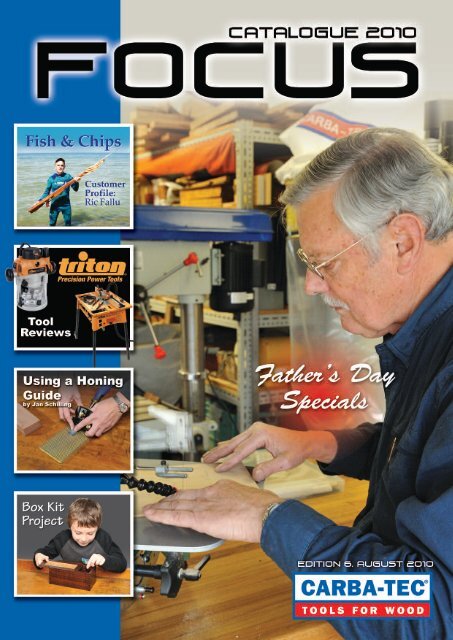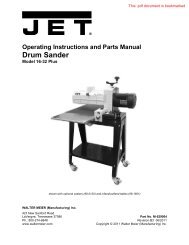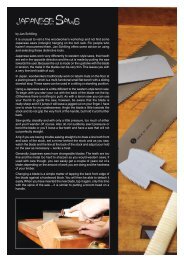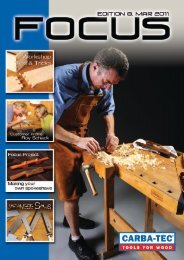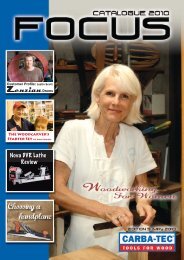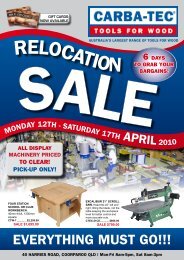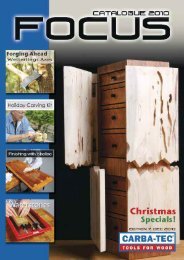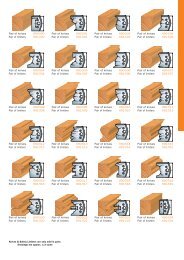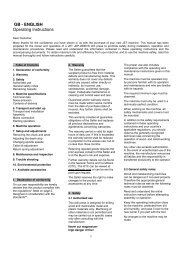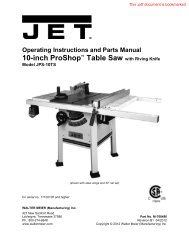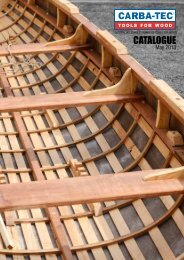You also want an ePaper? Increase the reach of your titles
YUMPU automatically turns print PDFs into web optimized ePapers that Google loves.
Figure 2.<br />
Figure 3. Remove the angle setter<br />
Hold honing guide flat<br />
onto face of stone<br />
Jan Schilling, a woodworker and teacher from Nimbin and the<br />
demonstrator of our Veritas handplane range, explains the virtues<br />
of the Veritas MK11 Honing Guide. Jan explains how you can easily<br />
achieve the angles you want on all your chisels and plane irons,<br />
she will also show you how to set an accurate micro bevel.<br />
The Veritas honing guide is one of the easiest systems to set-up and replicate existing blade<br />
angles with. For under $100, it’s well worth the investment and will remove the guesswork from<br />
setting your angles, allowing you to be confident that the edge you are working on is the best<br />
you can get.<br />
The honing guide comes in two parts – the actual honing guide and the angle setter. You will<br />
notice there are three colours and numbers on the guide. They are meant to be co-ordinated<br />
with the angle guide.<br />
Figure 1.<br />
Choose the angle you wish to hone at (25° is the most common angle for sharpening<br />
chisels and plane blades). Undo and slide the little indicator until it slots into the premarked<br />
holes on the angle guide. Slide the angle setter onto the honing guide (you will<br />
notice some numbers in inches) and roughly set it at the size of your chisel. It is not<br />
critical to be dead on – it just helps to have your chisel centered in the honing guide. Now<br />
nip up the knob on the angle guide until it is just firm, don’t over-tighten it.<br />
Figure 2.<br />
Hold the honing guide upside down and slide in your chosen blade until it touches the<br />
stop. Make sure the blade is against the edge of the angle setter. Hold the blade with<br />
your thumb and have your fingers on the back of the angle setter. This will allow you to<br />
look down the blade as you tighten the two brass screws evenly on the honing guide. If<br />
they are not tightened evenly, your blade may skew as you sharpen.<br />
Figure 3.<br />
Once you are happy the blade is secure in the honing guide, remove the angle setter, it<br />
is no longer required.<br />
If you use waterstones to sharpen on, make sure you do not just roll in one spot. Work around<br />
the stone and rotate it regularly. This will help prevent hollows forming in the face of your stone.<br />
Start with a coarse grit if you are intending to give the blade a full grind (probably around <strong>300</strong><br />
grit) and continue to sharpen until the entire edge is sharpened. You can feel a burr on the<br />
back of the blade and this will indicate that you have sharpened all the way along the blade.<br />
Change to an 800 grit stone and work your way to a 1200 grit and then finish on a 4000 grit<br />
or a 6000 grit. The 6000 grit water stone is broader and more suitable for use with the honing<br />
guide. If you don’t want to give the blade a full grind, you can begin with the 800 grit stone.<br />
Creating a Micro Bevel: On the bottom of the honing guide you will notice a knob with a mark<br />
on it. This will allow you to hone a micro bevel on your blade. Pull the knob out and turn it until<br />
the mark faces downwards. This raises the blade by one degree. Using one of the finer stones,<br />
a 1200 grit for example, roll the guide over the stone and you will see the micro bevel begin to<br />
form along the very edge of the blade. Continue with finer and finer grits of stone until you have<br />
reached your desired level of sharpness. The advantage of a micro<br />
bevel is that between sharpenings it is possible to give your blade<br />
a touch-up by honing only this small bevel on a fine stone.<br />
Accessories: The Veritas honing guide has two accessories<br />
that can be purchased separately. A cambered<br />
wheel is available to remove the square corners of a<br />
plane blade creating a slightly convex profile as you<br />
hone it. This prevents the corners of the blade from<br />
digging into the face of your work.<br />
Another accessory is the skew angle setter.<br />
This is useful for setting angles on<br />
some carving and bench<br />
chisels.<br />
Figure 1.<br />
Figure 4. Honing guide angle setter and<br />
accessory Camber wheel
Customer Profile - Ric Fallu<br />
Woodworking takes all different forms. For Ric Fallu, a <strong>Carba</strong>-<br />
<strong>Tec</strong> customer from Victoria, it is the ability to combine his love<br />
of the underwater world and fishing with a passion for woodworking<br />
that inspires him. In retirement, Ric has set himself a challenge<br />
to build in wood a series of classic speargun designs normally crafted<br />
in plastic and metal. This has proven to be a real test of ingenuity<br />
and skill. Along the way he has found companionship with<br />
fellow woodworkers and rediscovered a love of woodwork that has<br />
been with him for most of his life.<br />
My name is Ric Fallu and I build wooden spearguns. When I was four<br />
or five years old I discovered a wood rasp in the family garage and<br />
used it to shape wooden tent pegs. I nailed on a couple of pieces<br />
of board and voila! I had a toy airplane. I still have that wood rasp.<br />
A few years later I had my first experience of wearing a mask and<br />
snorkel in the sea. It was then I became hooked on the underwater<br />
world.<br />
In the early 1960s my education involved weekly visits to Carnegie<br />
school, where I was taught woodwork by Mr. Scott-Young. As well as<br />
basic skills, Mr. Scott-Young taught me the importance of precision<br />
and keeping a neat workplace. Both lessons have stayed with me<br />
lifelong.<br />
I later encountered ‘Handbook for Skindivers’ by Ben Cropp, it<br />
contained instructions on how to make a wooden speargun. I<br />
bought the book and made the gun, that was the beginning of a long<br />
journey.<br />
In the early 1970s, I was glazing-in a veranda and borrowed a handplane<br />
from my father. It was blunt and I didn’t have any instructions<br />
on how to sharpen it. I sat down and looked at the angles, it was<br />
like a light globe going off in my head. The appropriate angles<br />
became obvious. I sharpened the blade on an oilstone and it<br />
worked (if perhaps not brilliantly). I still have that plane.<br />
The years passed. Family issues and career development took<br />
precedence and I parted company with most of the hair on my head.<br />
I didn’t have the spare time to progress with my woodwork but when<br />
I was working in Darwin in the 1990s I enjoyed the tropical delights<br />
of skin-diving and spearfishing in Darwin Harbour (murky water, with<br />
crocodiles). One encounter with a large fish resulted in a broken<br />
speargun, as there is not a great demand for diving gear in Darwin<br />
(murky water, with crocodiles) and as I couldn’t get a replacement<br />
speargun, I decided to build one. I started and haven’t stopped<br />
since.<br />
Not long after that I discovered <strong>Carba</strong>-<strong>Tec</strong> ® and found a source of<br />
fine woodworking tools not readily available elsewhere. Not only are<br />
these tools functional, they are things of beauty in their own right.<br />
I finally retired from work to take up a life of indolence. I had to do<br />
something with my time, so this is how I began working my way<br />
through building the classic styles/designs of spearguns. Many of<br />
the designs were developed as a consequence of advances in plastic<br />
and metal technologies, it’s a real challenge nutting out how to<br />
duplicate the designs in wood.<br />
These are real working spearguns, built to take fish and withstand<br />
the hurly burly of freediving and spearfishing. I might be getting old<br />
on the outside but there is still a 19 year old on the inside that<br />
delights in the thrill of the chase.<br />
I learned the basics of woodwork back in the 1960s, but my skill<br />
level needed improvement. My joints were less than precise, and<br />
the glue-lines were too thick and variable. I joined the Wonthaggi<br />
Woodcrafters where I benefitted from the fellowship and skills of the<br />
other members. I also did a stint with the Melbourne School of Fine<br />
Woodworking.<br />
My joints are now much better (the<br />
wooden ones that is - I wish I could say<br />
the same about the ones on my skeleton).<br />
Mr. Scott-Young would have<br />
approved.<br />
I don't have much of a workshop, I<br />
use my garage at my coastal Victorian<br />
house and the garage at my partner's<br />
house in Melbourne. I do most of my<br />
work on a table on the front veranda.<br />
It's solid and weighty, and the top is<br />
soft pine that won't mark or dent my<br />
work-pieces. I have a power drill, a<br />
power planer, a hand held router, and<br />
of course - like just about every other<br />
household in Australia - I have a Triton<br />
saw bench, but I prefer to use hand<br />
tools wherever I can (the neighbours<br />
approve too). The local kids tell me I<br />
use the same tools used in Lord of<br />
the Rings. They think it's great.<br />
Spearguns have several key components.<br />
The stock is the backbone of the<br />
gun, and it has to be dead straight. My<br />
normal practice is to glue-up stocks<br />
from paired laminates (paired to balance<br />
stresses and ensure the stock<br />
timber doesn't move). Once the laminates<br />
have been ripped and left to<br />
readjust to their new shape, I flatten<br />
and smooth them with my #6 Veritas<br />
plane. I glue and clamp them to a<br />
straight form, and nowadays the gluelines<br />
are gratifyingly slim and even.<br />
I square glued-up stocks using the<br />
same plane, but I use a high angle Lie<br />
Nielson block plane for more detailed shaping. Epoxy is hard stuff<br />
and it takes a toll on plane blades. They need frequent sharpening,<br />
so I now use a Veritas guide and waterstones. It's faster and more<br />
accurate than the techniques I used in my youth and it puts a better<br />
edge on the blades too.<br />
As far as timber goes, some people will tell you that there are three<br />
timbers suitable for spearguns: Teak, Teak and Teak. I don't entirely<br />
agree. Timbers with a maritime tradition, such as Teak and Huon<br />
Pine, have a great wow factor and are lovely to work with, but the<br />
right stick of more common timbers can be just as functional and<br />
just as decorative, especially if they are appropriately sealed.<br />
I use Tasmanian Oak, Douglas Fir, and even Radiata Pine. The key<br />
requirement for speargun stocks is that the timber must be formed<br />
straight and stay straight - even if its water content varies - so this<br />
requires straight grain. Timber in handles and end-pieces can<br />
have a more interesting figure. Density affects buoyancy, and that<br />
needs to be taken into account.<br />
Speargun handles are designed to be ergonomically matched to the<br />
human hand. First, I cut them out with a coping saw, and then I<br />
shape them using the same wood rasp I used more than half a century<br />
ago. I do finer work with a Microplane, and then go on to sanding.<br />
I undertake commissions from time to time, but they are not really<br />
a commercial activity, especially not if you take time into account.<br />
It's the challenge that interests me.
Pre-Cut Box Kit Project<br />
Sliding Box<br />
These boxes may be dovetailed on a dovetail jig such as the Leigh Jig,<br />
or alternatively they may also be hand-dovetailed, box-jointed, mitred<br />
or joined through other means. Just be aware that if you choose other<br />
types of joinery for the project you might need to adjust the panel<br />
sizes.<br />
PACKAGE CONTENTS<br />
In your pack of beautiful Western Queensland hardwood timber you<br />
should have:<br />
BOX COMPONENTS<br />
2 of 200mm x 83mm x 8mm (long sides)<br />
2 of 100mm x 83mm x 8mm (short sides)<br />
1 of 192mm x 92mm x 8mm (neutral timber for base)<br />
FRAME AND PANEL LID<br />
1 of 168mm x 68mm x 8mm (decorative panel)<br />
3 of 200mm x 20mm x 8mm (2 x long sides for frame,<br />
and 1 to machine prior to cutting to size for smaller rails)<br />
ALL THE TIMBER IS KILN DRIED, CUT TO SIZE AND SANDED TO #150 GRIT<br />
Step 1: Layout<br />
A feature of this timber is that it has been end matched, being sawn from the one piece. You<br />
can therefore 'wrap' the timber around the box, matching the grain. Lay out your box and label<br />
the components clearly. It is also wise to label the corresponding edges to avoid confusion.<br />
Step 2: Dovetailing<br />
**REFER TO YOUR DOVETAIL JIG INSTRUCTIONS ON HOW TO CUT DOVETAILS.**<br />
On a Leigh® Jig, arrange your dovetail guide pins to suit the dimensions of the timber being<br />
machined. The dimensions used in these kits will also suit the <strong>Carba</strong>-<strong>Tec</strong> EuroJig® without<br />
modification. A backing piece is recommended to avoid chip-out when using dovetail jigs.<br />
Masking tape applied to the timber where the dovetails will be cut prior to machining will also<br />
help to prevent this. We recommend the use of CMT® Spiral <strong>Router</strong> bits for this task, as they<br />
will provide the cleanest cut.<br />
NOTE - If you are unfamiliar with your dovetail jig, it may be wise to machine some material<br />
to the same dimensions as your box components and cut sample dovetails to check the fit<br />
and the layout first.<br />
Step 3: Cutting the Grooves for the Bottom and the Sliding Top<br />
Dry assemble the box and hold it together with masking tape. Set up a 4mm slot cutter with a<br />
bearing in a router table. The grooves should be 4mm deep. Run the groove around the inside<br />
of the box, 4mm up from the edge, on both the top and bottom edges.<br />
NOTE - This will leave a rounded cavity in the corners. If you don't have a router table you<br />
can cut this groove on a tablesaw, with the box disassembled, but you may need to plug the<br />
ends of the dovetails where the blade comes through.<br />
Step 4: Rabbeting the Top and Bottom Plates<br />
To fit the bottom panel into the rebate you will need to create a tongue around the edge of the<br />
base board. A rabbeting bit is ideal. This tongue will need to be 4mm deep and a fraction<br />
under 4mm thick so it will comfortably fit into the 4mm rebate.<br />
If you have cut the rebate with the box assembled you will need to round the corners of your<br />
base before you cut the tongue. A 10 cent piece is ideal for this.<br />
Remember if you don't have a router table, the rabbet can be cut on a tablesaw on the same<br />
setting you used for your rebate.
Step 5: Gluing Up<br />
The panels should fit into the grooves about 4mm, leaving 1mm for movement. It is not necessary<br />
to glue the panels in, as they need to float so they can move with the changes of atmosphere.<br />
If you have routed the grooves with the box assembled as suggested (recommended), you will<br />
need to round the edges of the panels before machining the moulds, to suit the rounded cavity.<br />
A 10 cent piece is ideal to give you the correct curve.<br />
Step 6: Making the Sliding Lid<br />
The lid is a standard frame and loose panel construction. FIG. 9. It has a rabbet on 3 of its outer<br />
sides that fit into the groove on the top of the body of the box. The 4th outer edge is not rebated.<br />
SAFETY PRECAUTION- TO AVOID MACHINING VERY SMALL STOCK, WE PROVIDE THE<br />
FRAME IN THREE LONG PIECES. THESE ARE ALL TO BE REBATED, BEFORE ONE OF<br />
THE THREE IS CUT TO SIZE FOR THE SHORT RAILS OF THE FRAME. THE TENONS ARE<br />
THEN HAND CUT<br />
The frame is joined using an 8mm tenon on the ends of the rails. It fits into the 8mm rebate that<br />
runs right around the inside of the frame that houses the panel.<br />
A. Cutting the Grooves in the Frame<br />
Set up your router table with a 4mm slot cutter. Set up the fence so the slot cutter has only a<br />
small amount of clearance around it. Position the cutter height so the groove falls in the centre of<br />
the workpiece. The depth of the groove needs to be 8mm. Cut all three rail sections.<br />
B. Sizing the Rails & Cutting the Tenons<br />
After cutting the groove, you will need to cut the rail material to size. Cut 2 x 60mm lengths from<br />
one of the rail pieces for the short sides.<br />
It is safest to cut the small tenons on the rails by hand. Mark them out with a marking gauge.<br />
They are to be 4mm thick and 8mm deep and should run the full width of the 20mm wide rail.<br />
We suggest a fine precision Japanese Dozuki saw such as a WDG-150 or a Z-7029. These<br />
saws are perfect for fine accurate cuts such as is needed here.<br />
If you want to cut the tenons on a tablesaw take care doing this as the rails are tiny and your<br />
hands are close to the blade. Use a push block for support or better yet, make a jig to hold the<br />
rails. It may seem like a lot of trouble to go to, but jigs can save your fingers and/or your sanity.<br />
On a tablesaw set the height to 2mm (taken off each side), the thickness of the tongue (or<br />
tenon) should be 4mm, and a depth/width of 8mm.<br />
C. Moulding the Panel<br />
To fit the top panel into the frame you will need to reduce the thickness of the edges down to<br />
4mm by cutting a mould around the outside. A cove cutting bit, dish cutting/bowl and tray bit or<br />
similar is required. (a CMT® 851-502-11 is ideal). The panel fits into the 8mm groove that has<br />
been cut into the frame.<br />
D. Gluing the Lid<br />
Dry assemble the lid, make sure it all goes together well and the panel fits in to the frame.<br />
When you are happy, glue the lid together, check for square and gently clamp it overnight. Don't<br />
use too much clamping pressure which can distort the job, or too much glue. It can be hard removing<br />
all the squeeze out from the corners.<br />
E. Rabbeting the Lid<br />
Fine sand the sliding lid. The last job is to run a rabbet around 3 sides to slide into the top<br />
groove. This needs to be 4mm deep x 4mm wide. It can be done on a router table or a tablesaw.<br />
If you have cut the box rebate on a router with the box assembled, you will need to round the<br />
tongue to fit into the curved ends.Test the fit, the lid should slide easily and sit nicely into place.<br />
Step 7: Finishing<br />
Native western timbers take a variety of finishes very well and can be cabinet scraped or<br />
sanded to a very fine level, bringing out the natural oil in the timber. The more effort you put into<br />
this pre-finish routine, the greater the reward will be.<br />
Organoil® products, particularly the Hard Burnishing Oil are highly compatible with these beautiful<br />
timbers. ENJOY !!!
Pre-Cut Box Kit Project<br />
Split Lid Box<br />
These boxes may be dovetailed on a dovetail jig such as the Leigh Jig, or alternatively<br />
they may also be hand-dovetailed, box-jointed, mitred or joined through<br />
other rmeans. Just be aware that if you choose other types of joinery for the project<br />
you might need to adjust the panel sizes.<br />
PACKAGE CONTENTS<br />
In your pack of beautiful Western Queensland Hardwood timber you should<br />
have:<br />
2 of 250mm x 108mm x 10mm (Sides)<br />
2 of 150mm x 108mm x 10mm (Sides)<br />
2 of 250mm x 140mm x 8mm (One Decorative for lid and one for base)<br />
2 of 240mm x 70 mm x 2mm (Linings)<br />
2 of 140mm x 70 mm x 2mm (Linings)<br />
ALL THE TIMBER IS KILN DRIED, CUT TO SIZE AND SANDED TO #150 grit.<br />
Step 1: Layout<br />
A feature of this timber is that it has been end matched, being sawn from the one piece.<br />
You can therefore 'wrap' the timber around the box, matching the grain. Lay out your box<br />
and label the components clearly. It is also wise to label the corresponding edges to avoid<br />
confusion.<br />
Step 2: Dovetailing<br />
**REFER TO YOUR DOVETAIL JIG INSTRUCTIONS ON HOW TO CUT DOVETAILS.**<br />
On a Leigh® Jig, arrange your dovetail guide pins to suit the dimensions of the timber<br />
being machined. The dimensions used in these kits will also suit the <strong>Carba</strong>-<strong>Tec</strong> EuroJig®<br />
without modification. A backing piece is recommended to avoid chip-out when using dovetail<br />
jigs. Masking tape applied to the timber where the dovetails will be cut prior to machining<br />
will also help to prevent this. We recommend the use of CMT® spiral router bits for<br />
this task, as they will provide the cleanest cut.<br />
NOTE - If you are unfamiliar with your dovetail jig, it may be wise to machine some material<br />
to the same dimensions as your box components and cut sample dovetails to check<br />
the fit and the layout first.<br />
NOTE - This box is dovetailed and glued before the lid is cut off. You will therefore need to<br />
make the dovetail pin you are going to cut through, wider, by the same amount as the kerf<br />
of your sawblade or router bit. This will create uniform pin sizing overall. *This cannot be<br />
done on fixed template dovetail jigs such as the EuroJig®.*<br />
Step 3: Cutting the Grooves for the Top and Bottom<br />
Dry assemble the box and hold it together with masking tape. Set up a 4mm slot cutter<br />
with a bearing in a router table. You will want a depth of cut of about 5mm. Run your<br />
groove around the inside of the box top and bottom while it is assembled, leaving a space<br />
of about 5mm from the edge.<br />
NOTE - This will leave a rounded cavity in the corners. If you don't have a router table you<br />
can cut this groove on a tablesaw, with the box disassembled, but you may need to plug<br />
the ends of the dovetails where the blade comes through.<br />
Step 4: Rabbeting the Top and Bottom Plates<br />
To fit the top and bottom panels into the grooves you will need to reduce the thickness of<br />
the edge down to 4mm by cutting a mould around the outside of the top panel, using a<br />
cove cutting bit, dish cutting/bowl & tray bit or similar (CMT 851-502-11 is ideal). For the<br />
bottom panel a rabbeting bit can be used to create a tongue around the edge of the base.<br />
You may also use the same cutting bit as per the top if desired.
The panels should fit into the grooves about 4mm, leaving 1mm for movement. It is not<br />
necessary to glue the panels in, as they need to float so they can move with the changes<br />
of atmosphere.<br />
If you have routed the grooves with the box assembled as suggested (recommended),<br />
you will need to round the edges of the panels before machining the moulds, to suit the<br />
rounded cavity. A 10 cent piece is ideal to give you the correct curve.<br />
It is best to do most of the sanding of the top and bottom panels and the inside faces of<br />
the box panels before assembly. Next, do a dry test fit of all components. When happy<br />
with the fit, glue and assemble the box. Take care not to use too much glue. Excessive<br />
squeeze out will leave a mark under your finish, and it is not easy to wipe the excess off<br />
the inside of your box. We suggest using Titebond® Original wood glue as it creates a<br />
very strong joint, sands well and cleans up with water.<br />
Once the box is dry, do most of your external sanding before you cut the lid off. You may<br />
need to plane or sand the excess off the ends of the dovetails. This will seal the end grain<br />
beautifully.<br />
Step 5. Cutting off the Lid<br />
Make your cut through the wider pin if your design has included this feature. This can be<br />
done on the tablesaw with the blade set so it just cuts through the thickness of the material.<br />
It can also be cut on the router table with a very fine straight cutter or spiral bit (recommended).<br />
The spiral bit will give a planed finish to the edges and reduce chipping. A<br />
downcut spiral bit will give the least chipping out on the outside surface of the box. You will<br />
need to use a fence on the router table to give you a straight line and support. Whether<br />
you are cutting the lid off on a tablesaw or a router table, take care when cutting the fourth<br />
side as there may be movement in the lid.<br />
Step 6. Fitting the Lining<br />
The lining is designed to fit into the inside of the box and create a lip to support the box<br />
lid. Sand the lining before gluing. The inside of the box should already have been sanded.<br />
The linings can be mitred or butt joined to fit into the box. Note that they may require final<br />
trimming to size. Fix in place with a small amount of glue. This should create a very neat<br />
fitting for the box lid.<br />
Step 7. Finishing<br />
Native western timbers take finishes very well and can be cabinet scraped or sanded to a<br />
very fine level, bringing out the natural oil in the timber. The more effort you put into this<br />
the greater the reward will be. Finish choice for the box is purely a personal preference,<br />
however oil and wax gives a beautiful hand rubbed lustre to the dense nature of Western<br />
Hardwoods.<br />
Organoil products are perfect for the job, especially the Hard Burnishing Oil. ENJOY!!
TRI-TRA001B <strong>Router</strong> <strong>Review</strong><br />
Triton has directly addressed the difficulties in using a product<br />
upside down that has been primarily designed to be<br />
used right side up. The Triton TRI-TRA001B <strong>Router</strong> fulfils its<br />
design brief and really adds something special to your workshop.I<br />
use a shop-made router table to cut a lot of my joinery<br />
but I have never been entirely happy with any of the<br />
routers that I have fitted to it. They were all good quality,<br />
but they were primarily designed to be used upright or handheld.<br />
Using them in a table always involved a good deal of<br />
hassle when changing bits and when precision was needed<br />
in the set-up of particular cutters. However, you work with<br />
what you have and make allowances for its shortcomings.<br />
Until now!<br />
I have been testing the Triton TRI-TRA001B in the Triton<br />
<strong>Router</strong> <strong>Table</strong> System and am quite in awe of its features. I<br />
can't believe what I have been missing out on. It is obviously<br />
designed primarily to be used in a router table and<br />
solves most of the age-old problems associated with this. To<br />
begin with, the cooling vents are side-mounted to reduce<br />
the amount of sawdust that falls into the powerful 2400<br />
watts (3-1/4hp) motor. There is no sign of the motor wavering<br />
at all under load. It has a soft start and electronic<br />
variable speed that ranges between 8,000-21,000 RPM.<br />
This means router bits of all sizes can be safely used. It's<br />
important to remember that large diameter router bits such<br />
as panel raising bits or lock mitre bits should always be<br />
used in a router table and on a slower speed setting. There<br />
are two removable collets (one 1/4" and one 1/4"), so<br />
there is no need to use spacer collets unless you want to<br />
use 8mm router bits such as Leigh make.<br />
One of the best features of the TRI-TRA001B is its Dual<br />
Mode operation. A push of a button allows you to operate it<br />
as a standard plunge router when using it hand-held, or a<br />
fixed base router with a hand cranked rack and pinion height<br />
adjustment when table mounted. The plunge spring can be<br />
easily removed to allow effortless and smooth height adjustment<br />
either with a crank handle extension arm that<br />
comes through the table top for easy access or with the<br />
micro-adjust knob.<br />
Gone are the days of having to be a contortionist to set your<br />
router bit to the correct height. Changing router bits couldn't<br />
be easier. When the crank handle is turned all the way<br />
home a spindle lock is engaged. The router collet protrudes<br />
through the top allowing easy access with the spanner to<br />
change the bits. There is an added safety feature that ensures<br />
the spindle lock can only be engaged when the safety<br />
cover is over the switch and this will only work when the<br />
router is switched off. This safety feature also prevents the<br />
router from being switched back on while the spindle is<br />
locked. Because spanner access is from the base and not<br />
the side of the router there is a highly effective blade guard<br />
system and dust extraction outlet, not just the token attempt<br />
that you often see that still needs to allow side access.<br />
This does not however, obscure visibility when using<br />
the router in an upright position.<br />
The fence is a triumph although on first sight this may not<br />
be the impression that one gets. It consists of two components,<br />
a large plate that is attached to the router base plate<br />
via two spring-loaded pins that slide positively into keyhole<br />
slots. The fence itself connects to this plate. What I like a<br />
lot about this system is the enormous amount of surface<br />
area and support it gives you. It is perfect for large area<br />
hand-held work such as cutting rebates, trenches or sliding<br />
dovetails in panels. The weight of the router works with you<br />
to keep it stable and flat and the soft start reduces the<br />
chance of kickback or catching the material. The plate also<br />
gives you a nice safe position to place your hand for stabilising<br />
and supporting your router when working close to an<br />
edge.<br />
Being a router of considerable size and weight, the Triton<br />
TRI-TRA001B may prove to be a little heavy for some dovetail<br />
jigs that require you to hand hold it and move it across<br />
the top the comb. If you are using a Leigh jig, the Vacuum<br />
and <strong>Router</strong> Support will compensate for the weight and size,<br />
giving you much more stability. The KL-15 dovetail jig would<br />
be best used upside down on your router table as the comb<br />
is fairly narrow. If you are going to fit this router to a router<br />
table, consider going for the Triton Precision <strong>Router</strong> <strong>Table</strong><br />
System.<br />
Go to www.carbatec.com.au to see our whole range of Triton<br />
products as well as pricing.
<strong>RTA</strong> <strong>300</strong> <strong>Router</strong> <strong>Table</strong> <strong>Review</strong><br />
The <strong>RTA</strong> <strong>300</strong> <strong>Router</strong> <strong>Table</strong> can be mounted onto the Triton<br />
Work Cente (either the current model series 2000 or the<br />
older MK3) or fitted with the Triton <strong>Router</strong> <strong>Table</strong> Stand. It<br />
comes in flat pack form for self-assembly. It really is a good<br />
idea to use the manual and read it carefully. Give yourself a<br />
couple of hours to do it properly, any shortcuts you take will<br />
come back to haunt you. I would suggest using a straight<br />
edge to align the top plates and allow for the fact that you<br />
may need to do a bit of packing to achieve a flat surface.<br />
The Triton router is easily fitted using the same springloaded<br />
pins that hold the fence in place. There is also provision<br />
to fit other brands of router using the clamps<br />
supplied.<br />
There are several add-on accessories that can be purchased<br />
to fit onto the Triton <strong>Router</strong> <strong>Table</strong>. They include Triton's Biscuit<br />
Jointer System, as well as a Finger Joint Kit and a Jigsaw<br />
Kit. These are all designed to fit onto the router table<br />
and can be purchased separately at any time. Standard<br />
equipment supplied with the router table includes; side and<br />
downward pressure fingers and a two-piece split fence with<br />
a height adjustable guarding with a dust port. For planing<br />
cuts there are 1/2mm and 1mm shims that slide behind<br />
the outfeed fence.<br />
I really like the way that every accessory has a home on the<br />
router table so there is little chance of losing them so long<br />
as they are put back. The planing shims slide neatly onto<br />
their storage pegs behind the fence. There are also removable<br />
micro-adjust fittings that lock into slots behind each<br />
side of the fence.<br />
The MDF lockable sled houses an adjustable fence and<br />
mitre gauge. The sled can be used in a fixed position or as<br />
a small sliding table. A sacrificial fence added to the mitre<br />
gauge is great for tricky end-grain work.<br />
For freehanding shaped material, the fence can be removed<br />
and stored on hooks at the side. The clear cutter guard<br />
comes off the fence and fits directly onto the table. The<br />
edge of this guard acts as an infeed pin for leading into cuts<br />
to prevent the bit from grabbing.<br />
The <strong>RTA</strong> <strong>300</strong> <strong>Router</strong> <strong>Table</strong> combined with the Triton <strong>Router</strong><br />
gives you a very effective workstation capable of performing<br />
just about all routing operations with ease and safety. There<br />
is enormous scope to add other accessories and increase<br />
the range of what you can do.<br />
As long as you take care with assembly and ensure all the<br />
plates line up you will achieve many years of happy woodworking.<br />
To existing Triton users I am not telling you anything you<br />
don't already know, but for those of us that have been a bit<br />
slower to pick up on it, take a closer look at this Australian<br />
tradition because it's well worth it.<br />
Go to www.carbatec.com.au to see our whole range of Triton<br />
products as well as pricing.
Brisbane <strong>Carba</strong>-<strong>Tec</strong> ® staff member Andy Lucas explains why he loves the Excalibur scroll saw.<br />
The scroll saw is a very versatile machine to include in your workshop kit. The range of tasks it can handle is limited only by your imagination,<br />
whether your interest is in art, craft, toymaking, intarsia or other aspects of woodworking.There are many publications available to guide you<br />
through the variety of craft and hobby projects that may be of interest. <strong>Carba</strong>-<strong>Tec</strong> stock a wide range of instruction and pattern books for those<br />
just starting out as well as experienced scrollers. Some newsagencies and internet sites also stock magazines and patterns that you can buy<br />
or download.<br />
Just as there are a wide variety of tasks that can be handled by scroll saws, there are also a great variety of models and prices to consider.<br />
Your first step should be to identify the sort of work you will be doing, then you'll be able to select the machine that covers your needs and fits<br />
your budget. Entry level machines primarily allow external cutting with pinned blades. These are fine for basic projects, and prices for these<br />
machines start around $140. However, if you intend to do finer detail work with internal cutting you will need to look for a machine that uses<br />
pinless blades, preferably a machine that allows easy fitting and quick release of the blades.<br />
I have used a wide variety of machines over the past eight years with mixed levels of success and frustration. Without a doubt, when you are<br />
working on projects with multiple fine internal cuts, blade release from the bottom clamp and the ability to raise the upper arm and blade out<br />
of each cut makes scrolling a much more enjoyable hobby. The Excalibur scroll saw has this feature and many more that make it, in my opinion,<br />
the best machine available on the market.<br />
Other features include:<br />
Quick blade changes with finger operated blade clamps, no tools required.<br />
Head tilts 45° left and right, tilting the blade, not the table, keeping the workpiece level for better control, more accurate cuts and<br />
safer usage.<br />
Easy access speed and tension controls.<br />
Organised blade storage on base.<br />
Onboard dust blower.<br />
Positive stops at common angles.<br />
I had the pleasure of demonstrating the Excalibur at last November's "Hands On" exhibition in Brisbane. The aim was to focus on getting new<br />
users to try the machine. We had a series of basic jigsaw patterns copied onto 19mm radiata pine board pieces. After a brief introduction to<br />
safety and operating procedures, a number of volunteers tested the machine and were impressed with the ease of operation. Most kept their<br />
completed project as a souvenir of their experience.<br />
The Excalibur scroll saw is an easy machine to use and to gain confidence with. There is no vibration or blade wobble as occurs with some of<br />
the lighter machines. The oblong, heavy-duty steel table surface supports your workpiece, making it easy to manipulate the most complex of<br />
cuts and designs - whether you are using a standard profile blade or a spiral profile cutting blade.<br />
Other points to consider when you start your scrolling include blade selection to suit the task at hand, speed range to suit the material being<br />
cut, blade tension to maintain cut direction control and also feed rate of the material into the cutting blade. These issues are covered in many<br />
of the scrolling publications and also become apparent with continued practice and projects.<br />
Blade selection is made easier with the extensive range of Olson® scroll saw blades that <strong>Carba</strong>-<strong>Tec</strong> stocks. Each blade<br />
pack has the manufacturer's recommendation for specified use of the blade profile, in particular<br />
its suitability for use with timber, MDF, brass or aluminium sheet, etc.<br />
Excalibur scroll saws come in two different sizes - a 21" and a 30" model. I encourage<br />
you to enter the wonderful world of scrolling, and highly recommend the Excalibur as<br />
the machine to give you the most satisfaction and success.<br />
Go to www.carbatec.com.au to see our range of products and pricing<br />
Focus Project:<br />
Scroll Saw Family<br />
Portrait, go to<br />
Focus issue<br />
December 2010


